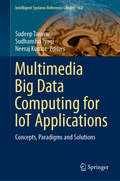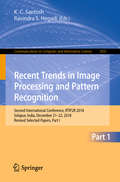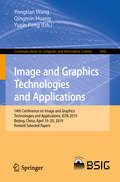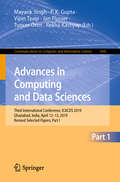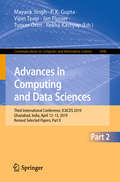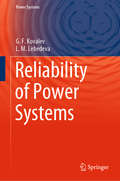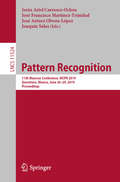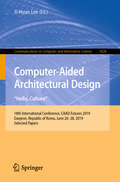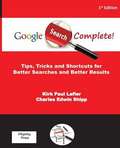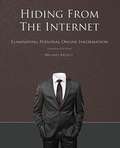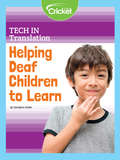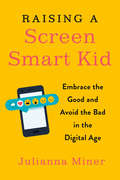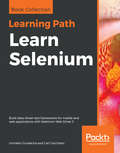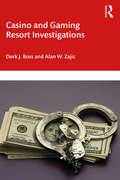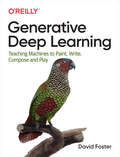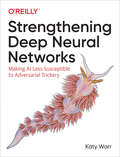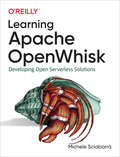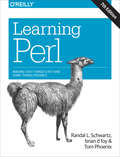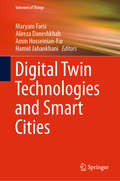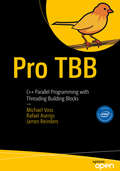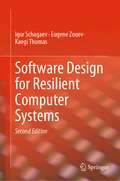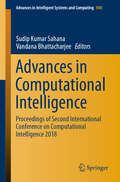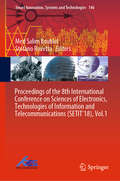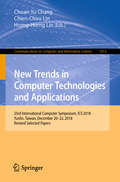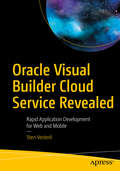- Table View
- List View
Multimedia Big Data Computing for IoT Applications: Concepts, Paradigms and Solutions (Intelligent Systems Reference Library #163)
by Sudeep Tanwar Sudhanshu Tyagi Neeraj KumarThis book considers all aspects of managing the complexity of Multimedia Big Data Computing (MMBD) for IoT applications and develops a comprehensive taxonomy. It also discusses a process model that addresses a number of research challenges associated with MMBD, such as scalability, accessibility, reliability, heterogeneity, and Quality of Service (QoS) requirements, presenting case studies to demonstrate its application. Further, the book examines the layered architecture of MMBD computing and compares the life cycle of both big data and MMBD. Written by leading experts, it also includes numerous solved examples, technical descriptions, scenarios, procedures, and algorithms.
Recent Trends in Image Processing and Pattern Recognition: Second International Conference, RTIP2R 2018, Solapur, India, December 21–22, 2018, Revised Selected Papers, Part I (Communications in Computer and Information Science #1035)
by K. C. Santosh Ravindra S. HegadiThis three-book set constitutes the refereed proceedings of the Second International Conference on Recent Trends in Image Processing and Pattern Recognition (RTIP2R) 2018, held in Solapur, India, in December 2018.The 173 revised full papers presented were carefully reviewed and selected from 374 submissions. The papers are organized in topical sections in the tree volumes. Part I: computer vision and pattern recognition; machine learning and applications; and image processing. Part II: healthcare and medical imaging; biometrics and applications. Part III: document image analysis; image analysis in agriculture; and data mining, information retrieval and applications.
Image and Graphics Technologies and Applications: 14th Conference on Image and Graphics Technologies and Applications, IGTA 2019, Beijing, China, April 19–20, 2019, Revised Selected Papers (Communications in Computer and Information Science #1043)
by Yongtian Wang Qingmin Huang Yuxin PengThis book constitutes the refereed proceedings of the 14th Conference on Image and Graphics Technologies and Applications, IGTA 2019, held in Beijing, China in April, 2019. The 66 papers presented were carefully reviewed and selected from 152 submissions. They provide a forum for sharing progresses in the areas of image processing technology; image analysis and understanding; computer vision and pattern recognition; big data mining, computer graphics and VR, as well as image technology applications.
Advances in Computing and Data Sciences: Third International Conference, ICACDS 2019, Ghaziabad, India, April 12–13, 2019, Revised Selected Papers, Part I (Communications in Computer and Information Science #1045)
by Mayank Singh P. K. Gupta Vipin Tyagi Jan Flusser Tuncer Ören Rekha KashyapThis two-volume set (CCIS 1045 and CCIS 1046) constitutes the refereed proceedings of the Third International Conference on Advances in Computing and Data Sciences, ICACDS 2019, held in Ghaziabad, India, in April 2019.The 112 full papers were carefully reviewed and selected from 621 submissions. The papers are centered around topics like advanced computing, data sciences, distributed systems organizing principles, development frameworks and environments, software verification and validation, computational complexity and cryptography, machine learning theory, database theory, probabilistic representations.
Advances in Computing and Data Sciences: Third International Conference, ICACDS 2019, Ghaziabad, India, April 12–13, 2019, Revised Selected Papers, Part II (Communications in Computer and Information Science #1046)
by Mayank Singh P. K. Gupta Vipin Tyagi Jan Flusser Tuncer Ören Rekha KashyapThis two-volume set (CCIS 1045 and CCIS 1046) constitutes the refereed proceedings of the Third International Conference on Advances in Computing and Data Sciences, ICACDS 2019, held in Ghaziabad, India, in April 2019.The 112 full papers were carefully reviewed and selected from 621 submissions. The papers are centered around topics like advanced computing, data sciences, distributed systems organizing principles, development frameworks and environments, software verification and validation, computational complexity and cryptography, machine learning theory, database theory, probabilistic representations.
Reliability of Power Systems (Power Systems)
by G.F. Kovalev L.M. LebedevaThis book presents essential methods and tools for research into the reliability of energy systems. It describes in detail the content setting, formalisation, and use of algorithms for assessing the reliability of modern, large, and complex electric power systems. The book uses a wealth of tables and illustrations to represent results and source information in a clear manner. It discusses the main operating conditions which affect the reliability of electric power systems, and describes corresponding computing tools which can help solve issues as they arise. Further, all methodologies presented here are demonstrated in numerical examples. Though primarily intended for researchers and practitioners in the field of electric power systems, the book will also benefit general readers interested in this area.
Pattern Recognition: 11th Mexican Conference, MCPR 2019, Querétaro, Mexico, June 26–29, 2019, Proceedings (Lecture Notes in Computer Science #11524)
by Jesús Ariel Carrasco-Ochoa José Francisco Martínez-Trinidad José Arturo Olvera-López Joaquín SalasThis book constitutes the proceedings of the 11th Mexican Conference on Pattern Recognition, MCPR 2019, held in Querétaro, Mexico, in June 2019. The 40 papers presented in this volume were carefully reviewed and selected from 86 submissions. They were organized in topical sections named: artificial intelligence techniques and recognition; computer vision; industrial and medical applications of pattern recognition; image processing and analysis; pattern recognition techniques; signal processing and analysis; natural language, and processing and recognition.
Computer-Aided Architectural Design. "Hello, Culture": 18th International Conference, CAAD Futures 2019, Daejeon, Republic of Korea, June 26–28, 2019, Selected Papers (Communications in Computer and Information Science #1028)
by Ji-Hyun LeeThis book constitutes selected papers of the 18th International Conference on Computer-Aided Architectural Design Futures, CAAD Futures 2019, held in Daejeon, Republic of Korea, in June 2019. The 34 revised full papers presented were carefully reviewed and selected from 194 submissions. The papers are organized in topical sections on theory, methodology and practice of architectural and interior design; support systems for design decisions; tools, methods and implementation of urban design; rethinking space and spatial behavior; fabrication and materialization; and shape studies.
Google Search Complete: Tips, Tricks and Shortcuts for Better Searches and Better Results
by Kirk Paul Lafler; Charles Edwin ShippFilled with useful tips, techniques and shortcuts, Google Search Complete! provides insights on how Google search works and illustrates numerous examples to find websites, people, businesses, articles of interest, reference works, information tools, directories, PDFs, images, current news stories, user and professional groups, and other content.
Hiding from the Internet: Eliminating Personal Online Information
by Michael BazzellThe author provides personal experiences from his journey to disappear from public view. Much of the content of this book has never been discussed in any publication. Always thinking like a hacker, the author has identified new ways to force companies to remove you from their data collection systems. This book exposes loopholes that create unique opportunities for privacy seekers.
Tech in Translation
by Carollyne HutterIn Morocco, deaf children were at a disadvantage when it comes to their education. When Dr. Abdelhadi Soudi built a computer program that can translate sign language, it improved the way Morocco teaches their deaf children by leaps and bounds!
Raising a Screen-Smart Kid: Embrace the Good and Avoid the Bad in the Digital Age
by Julianna MinerFor parents who didn't grow up with smartphones but can't let go of them now, expert advice on raising kids in our constantly connected worldMost kids get their first smartphone at the same time that they're experiencing major developmental changes. Making mistakes has always been a part of growing up, but how do parents help their kids navigate childhood and adolescence at a time when social media has the potential to magnify the consequences of those mistakes? Rather than spend all their time worrying about the worst-case scenario, readers get a bigger-picture understanding of their kids' digital landscape. Drawing on research and interviews with educators, psychologists, and kids themselves, Raising a Screen-Smart Kid offers practical advice on how parents can help their kids avoid the pitfalls and reap the benefits of the digital age by: * using social media to enhance connection with friends and family, instead of following strangers and celebrities, which is a predictor of loneliness and depression * finding online support and community for conditions such as depression and eating disorders, while avoiding potential triggers such as #Thinspiration Pinterest boards * learning and developing life skills through technology--for example, by problem-solving in online games--while avoiding inappropriate contentWritten by a public health expert and the creator of the popular blog Rants from Mommyland, this book shows parents how to help their kids navigate friendships, bullying, dating, self-esteem, and more online.
Learn Selenium: Build data-driven test frameworks for mobile and web applications with Selenium Web Driver 3
by Unmesh Gundecha Carl CocchiaroLearn end-to-end automation testing techniques for web and mobile browsers using Selenium WebDriver, AppiumDriver, Java, and TestNG Key Features Explore the Selenium grid architecture and build your own grid for browser and mobile devices Use ExtentReports for processing results and SauceLabs for cloud-based test services Unlock the full potential of Selenium to test your web applications. Book Description Selenium WebDriver 3.x is an open source API for testing both browser and mobile applications. With the help of this book, you can build a solid foundation and can easily perform end-to-end testing on web and mobile browsers.You'll begin by being introduced to the Selenium Page Object Model for software development. You'll architect your own framework with a scalable driver class, Java utility classes, and support for third-party tools and plugins. You'll design and build a Selenium grid from scratch to enable the framework to scale and support different browsers, mobile devices, and platforms.You'll strategize and handle a rich web UI using the advanced WebDriver API and learn techniques to handle real-time challenges in WebDriver. You'll perform different types of testing, such as cross-browser testing, load testing, and mobile testing. Finally, you will also be introduced to data-driven testing, using TestNG to create your own automation framework.By the end of this Learning Path, you'll be able to design your own automation testing framework and perform data-driven testing with Selenium WebDriver. This Learning Path includes content from the following Packt products: Selenium WebDriver 3 Practical Guide - Second Edition by Unmesh Gundecha Selenium Framework Design in Data-Driven Testing by Carl Cocchiaro What you will learn Use different mobile and desktop browser platforms with Selenium 3 Use the Actions API for performing various keyboard and mouse actions Design the Selenium Driver Class for local, remote, and third-party grid support Build page object classes with the Selenium Page Object Model Develop data-driven test classes using the TestNG framework Encapsulate data using the JSON protocol Build a Selenium Grid for RemoteWebDriver testing Build and use utility classes in synchronization, file I/O, reporting and test listener classes Who this book is for This Learning Path is ideal for software quality assurance/testing professionals, software project managers, or software developers interested in using Selenium for testing their applications. Professionals responsible for designing and building enterprise-based testing frameworks will also find this Learning Path useful. Prior programming experience in Java are TestNG is necessary.
Casino and Gaming Resort Investigations
by Derk J. Boss Alan W. ZajicCasino and Gaming Resort Investigations addresses the continued and growing need for gaming security professionals to properly and successfully investigate the increasing and unique types of crime they will face in their careers. As the gaming industry has grown, so has the need for competent and highly skilled investigators who must be prepared to manage a case of employee theft one day to a sophisticated sports book scam the next. This book provides the reader with the fundamental knowledge needed to understand how each gaming and non-gaming department functions and interacts within the overall gaming resort, allowing the investigator to determine and focus on the important elements of any investigation in any area. Each chapter delivers a background of a department or type of crime normally seen in the gaming environment, and then discusses what should be considered important or even critical for the investigator to know or determine in the course of the investigation. Likely scenarios, case histories, and tips, as well as cautions for investigators to be aware of, are used throughout the book. This book was written for and directed at gaming security and surveillance professionals, including gaming regulators, and tribal gaming authorities, who are almost daily confronted by the ingenious and the most common scams, theft, and frauds that are perpetrated in the gaming world.
Generative Deep Learning: Teaching Machines to Paint, Write, Compose, and Play
by David FosterGenerative modeling is one of the hottest topics in AI. It’s now possible to teach a machine to excel at human endeavors such as painting, writing, and composing music. With this practical book, machine-learning engineers and data scientists will discover how to re-create some of the most impressive examples of generative deep learning models, such as variational autoencoders, generative adversarial networks (GANs), encoder-decoder models and world models.Author David Foster demonstrates the inner workings of each technique, starting with the basics of deep learning before advancing to some of the most cutting-edge algorithms in the field. Through tips and tricks, you’ll understand how to make your models learn more efficiently and become more creative. Discover how variational autoencoders can change facial expressions in photos; Build practical GAN examples from scratch, including CycleGAN for style transfer and MuseGAN for music generation; Create recurrent generative models for text generation and learn how to improve the models using attention; Understand how generative models can help agents to accomplish tasks within a reinforcement learning setting; Explore the architecture of the Transformer (BERT, GPT-2) and image generation models such as ProGAN and StyleGAN.
Strengthening Deep Neural Networks: Making AI Less Susceptible to Adversarial Trickery
by Katy WarrAs deep neural networks (DNNs) become increasingly common in real-world applications, the potential to deliberately "fool" them with data that wouldn’t trick a human presents a new attack vector. This practical book examines real-world scenarios where DNNs—the algorithms intrinsic to much of AI—are used daily to process image, audio, and video data.Author Katy Warr considers attack motivations, the risks posed by this adversarial input, and methods for increasing AI robustness to these attacks. If you’re a data scientist developing DNN algorithms, a security architect interested in how to make AI systems more resilient to attack, or someone fascinated by the differences between artificial and biological perception, this book is for you.Delve into DNNs and discover how they could be tricked by adversarial inputInvestigate methods used to generate adversarial input capable of fooling DNNsExplore real-world scenarios and model the adversarial threatEvaluate neural network robustness; learn methods to increase resilience of AI systems to adversarial dataExamine some ways in which AI might become better at mimicking human perception in years to come
Learning Apache OpenWhisk: Developing Open Serverless Solutions
by Michele SciabarràServerless computing greatly simplifies software development. Your team can focus solely on your application while the cloud provider manages the servers you need. This practical guide shows you step-by-step how to build and deploy complex applications in a flexible multicloud, multilanguage environment using Apache OpenWhisk. You’ll learn how this platform enables you to pursue a vendor-independent approach using preconfigured containers, microservices, and Kubernetes as your cloud operating system. Michele Sciabarrà demonstrates how to build a serverless application using classical design patterns and the programming language or languages that best fit your task. You’ll start by building a simple serverless application hands-on before diving into the more complex aspects of the OpenWhisk platform. Examine how OpenWhisk’s serverless architecture works, including the use of packages, actions, sequences, triggers, rules, and feeds; Learn how OpenWhisk compares to existing architectures, such as Java Enterprise Edition; Manipulate OpenWhisk features using the command-line interface or a JavaScript API; Design applications using common Gang of Four design patterns; Use architectural design patterns such as model-view-controller to combine several OpenWhisk actions; Learn how to test and debug your code in a serverless environment.
Learning Perl: Making Easy Things Easy and Hard Things Possible (In a Nutshell)
by Randal L. Schwartz Tom Phoenix Brian D FoyIf you're just getting started with Perl, this is the book you want--whether you're a programmer, system administrator, or web hacker. Nicknamed "the Llama" by two generations of users, this bestseller closely follows the popular introductory Perl course taught by the authors since 1991. This seventh edition covers recent changes to the language up to version 5.24.Perl is suitable for almost any task on almost any platform, from short fixes to complete web applications. Learning Perl teaches you the basics and shows you how to write programs up to 128 lines long--roughly the size of 90% of the Perl programs in use today. Each chapter includes exercises to help you practice what you've just learned. Other books may teach you to program in Perl, but this book will turn you into a Perl programmer.Topics include:Perl data and variable typesSubroutinesFile operationsRegular expressionsString manipulation (including Unicode)Lists and sortingProcess managementSmart matchingUse of third party modules
Digital Twin Technologies and Smart Cities (Internet of Things)
by Maryam Farsi Alireza Daneshkhah Amin Hosseinian-Far Hamid JahankhaniThis book provides a holistic perspective on Digital Twin (DT) technologies, and presents cutting-edge research in the field. It assesses the opportunities that DT can offer for smart cities, and covers the requirements for ensuring secure, safe and sustainable smart cities. Further, the book demonstrates that DT and its benefits with regard to: data visualisation, real-time data analytics, and learning leading to improved confidence in decision making;reasoning, monitoring and warning to support accurate diagnostics and prognostics;acting using edge control and what-if analysis; andconnection with back-end business applications hold significant potential for applications in smart cities, by employing a wide range of sensory and data-acquisition systems in various parts of the urban infrastructure. The contributing authors reveal how and why DT technologies that are used for monitoring, visualising, diagnosing and predicting in real-time are vital to cities’ sustainability and efficiency. The concepts outlined in the book represents a city together with all of its infrastructure elements, which communicate with each other in a complex manner. Moreover, securing Internet of Things (IoT) which is one of the key enablers of DT’s is discussed in details and from various perspectives. The book offers an outstanding reference guide for practitioners and researchers in manufacturing, operations research and communications, who are considering digitising some of their assets and related services. It is also a valuable asset for graduate students and academics who are looking to identify research gaps and develop their own proposals for further research.
Pro TBB: C++ Parallel Programming with Threading Building Blocks
by Michael Voss Rafael Asenjo James ReindersThis open access book is a modern guide for all C++ programmers to learn Threading Building Blocks (TBB). Written by TBB and parallel programming experts, this book reflects their collective decades of experience in developing and teaching parallel programming with TBB, offering their insights in an approachable manner. Throughout the book the authors present numerous examples and best practices to help you become an effective TBB programmer and leverage the power of parallel systems.Pro TBB starts with the basics, explaining parallel algorithms and C++'s built-in standard template library for parallelism. You'll learn the key concepts of managing memory, working with data structures and how to handle typical issues with synchronization. Later chapters apply these ideas to complex systems to explain performance tradeoffs, mapping common parallel patterns, controlling threads and overhead, and extending TBB to program heterogeneous systems or system-on-chips. What You'll LearnUse Threading Building Blocks to produce code that is portable, simple, scalable, and more understandableReview best practices for parallelizing computationally intensive tasks in your applicationsIntegrate TBB with other threading packagesCreate scalable, high performance data-parallel programsWork with generic programming to write efficient algorithmsWho This Book Is ForC++ programmers learning to run applications on multicore systems, as well as C or C++ programmers without much experience with templates. No previous experience with parallel programming or multicore processors is required.
Software Design for Resilient Computer Systems
by Igor Schagaev Eugene Zouev Kaegi ThomasThis book addresses the question of how system software should be designed to account for faults, and which fault tolerance features it should provide for highest reliability. With this second edition of Software Design for Resilient Computer Systems the book is thoroughly updated to contain the newest advice regarding software resilience. With additional chapters on computer system performance and system resilience, as well as online resources, the new edition is ideal for researchers and industry professionals.The authors first show how the system software interacts with the hardware to tolerate faults. They analyze and further develop the theory of fault tolerance to understand the different ways to increase the reliability of a system, with special attention on the role of system software in this process. They further develop the general algorithm of fault tolerance (GAFT) with its three main processes: hardware checking, preparation for recovery, and the recovery procedure. For each of the three processes, they analyze the requirements and properties theoretically and give possible implementation scenarios and system software support required. Based on the theoretical results, the authors derive an Oberon-based programming language with direct support of the three processes of GAFT. In the last part of this book, they introduce a simulator, using it as a proof of concept implementation of a novel fault tolerant processor architecture (ERRIC) and its newly developed runtime system feature-wise and performance-wise. Due to the wide reaching nature of the content, this book applies to a host of industries and research areas, including military, aviation, intensive health care, industrial control, and space exploration.
Advances in Computational Intelligence: Proceedings of Second International Conference on Computational Intelligence 2018 (Advances in Intelligent Systems and Computing #988)
by Sudip Kumar Sahana Vandana BhattacharjeeThis book presents the proceedings of the International Conference on Computational Intelligence 2018 (ICCI 2018). It brings together work by leading scientists, researchers and research scholars from around the globe on all aspects of computational intelligence. The work is mainly composed of the original and unpublished results of conceptual, constructive, empirical, experimental, or theoretical work in all areas of computational intelligence. Specifically, the major topics covered include classical computational intelligence models and artificial intelligence, neural networks and deep learning, evolutionary swarm and particle algorithms, hybrid systems optimization, constraint programming, human–machine interaction, computational intelligence for web analytics, robotics, computational neurosciences, neurodynamics, bioinspired and biomorphic algorithms, cross-disciplinary topics and applications.
Proceedings of the 8th International Conference on Sciences of Electronics, Technologies of Information and Telecommunications (Smart Innovation, Systems and Technologies #146)
by Med Salim Bouhlel Stefano RovettaThis two-volume book presents an unusually diverse selection of research papers, covering all major topics in the fields of information and communication technologies and related sciences. It provides a wide-angle snapshot of current themes in information and power engineering, pursuing a cross-disciplinary approach to do so. The book gathers revised contributions that were presented at the 2018 International Conference: Sciences of Electronics, Technologies of Information and Telecommunication (SETIT'18), held on 20–22 December 2018 in Hammamet, Tunisia. This eighth installment of the event attracted a wealth of submissions, and the papers presented here were selected by a committee of experts and underwent additional, painstaking revision. Topics covered include:· Information Processing · Human-Machine Interaction · Computer Science · Telecommunications and Networks · Signal Processing · Electronics · Image and Video This broad-scoped approach is becoming increasingly popular in scientific publishing. Its aim is to encourage scholars and professionals to overcome disciplinary barriers, as demanded by current trends in the industry and in the consumer market, which are rapidly leading toward a convergence of data-driven applications, computation, telecommunication, and energy awareness.Given its coverage, the book will benefit graduate students, researchers and practitioners who need to keep up with the latest technological advances.
New Trends in Computer Technologies and Applications: 23rd International Computer Symposium, ICS 2018, Yunlin, Taiwan, December 20–22, 2018, Revised Selected Papers (Communications in Computer and Information Science #1013)
by Chuan-Yu Chang Chien-Chou Lin Horng-Horng LinThe present book includes extended and revised versions of papers presented during the 2018 International Computer Symposium (ICS 2018), held in Yunlin, Republic of China (Taiwan), on December 20-22, 2018.The 86 papers presented were carefully reviewed and selected from 263 submissions from 11 countries. The variety of the topics include machine learning, sensor devices and platforms, sensor networks, robotics, embedded systems, networks, operating systems, software system structures, database design and models, multimedia and multimodal retrieval, object detection, image processing, image compression, mobile and wireless security.
Oracle Visual Builder Cloud Service Revealed: Rapid Application Development for Web and Mobile
by Sten VesterliBuild and deploy an attractive, user-friendly web or mobile application in one day or less using Oracle’s new, low-code development tool: Visual Builder Cloud Service.Today’s IT world is fast-paced, and the ability to rapidly deliver running code is the most crucial and sought-after skill a developer can have. Oracle has brought together their enterprise experience, advanced usability knowledge, and their best cloud engineering to produce an innovative platform giving developers unprecedented productivity.You will learn how to use all aspects of Oracle Visual Builder Cloud Service to build web or mobile applications. Using the fully browser-based development environment, you’ll gain experience with all the modern user-interface components that the tool offers for a visual, user-interface-driven, development approach. You'll also see how to use the integrated data management capabilities and existing REST data services to store your data, and learn how to easily transfer applications to a test/staging environment and later to production, while continuing to develop the next version in the development environment.What You'll LearnBuild great-looking web and mobile applications in a browser-based, visual design environmentDefine custom business logic in the visual logic editor or with JavaScriptManage multiple concurrent application versions from development through staging and productionDefine business objects with validation logic for application-specific dataCommunicate with, and draw data from, existing REST web servicesUse Visual Builder Cloud Service to expand Oracle SaaS solutionsWho This Book Is ForDevelopers at all expertise levels as well as business professionals and UX designers with an interest in using IT to quickly solve simple business problems. Because this tool is based on a modern low-code approach, no prior programming experience is necessary to benefit from the book.
